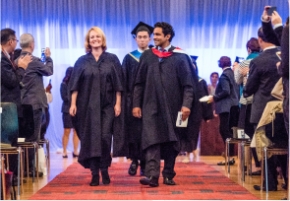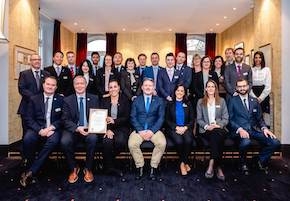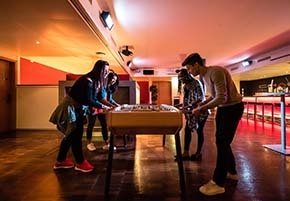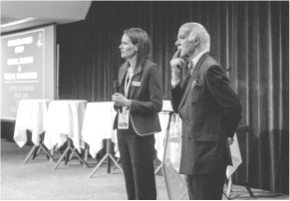- About
- Programs
- Innovation & Research
- Campus Life
- Career Services
- Admissions
- News & Events
- Alumni
What Does Innovation Really Mean Today? Types and Trends
Discover what innovation really means today. Explore new definitions, trends, and examples shaping the future. Read now to stay ahead.
Key Takeaways
- Innovation was once defined by major inventions and measured by patents or research output.
- Modern innovation focuses on solving real problems, improving systems, adapting to change, and creating lasting value.
- There are different types of innovation, including incremental, disruptive, social, and sustainable.
- Challenges to innovation include resistance to change, budget constraints, regulatory hurdles, and complicated implementation.
One of the things that sets humans apart from other species on Earth is our unmatched ability to innovate. In just a few thousand years, we've gone from lighting fires with stones to splitting atoms, from cave drawings to touchscreen phones.
Unlike discoveries, which exist independently of us, innovation is deliberate. It happens because of us. It reflects the way we create or take what exists and rethink it entirely.
Still, for something so central to human progress, the definition of innovation isn't easy to pin down. That's partly because the way we understand it has evolved. What counted as innovation centuries ago might not hold the same meaning today. Still, if history is proof of anything, it's that innovation never stops mattering.
The Traditional Definition of Innovation
For much of history, innovation was seen as the domain of inventors, scientists, industrialists, and engineers. It was primarily associated with monumental breakthroughs, like steam engines, light bulbs, vaccines, printing presses, airplanes, and other concrete achievements born from experimentation, research, and at times, even serendipity.
Innovation was primarily measured in patents and the launch of something entirely unprecedented. In this view, creativity was simply seen as the starting point. The real innovation was what followed in laboratories and corporate R&D departments.
Your Leadership Journey Starts Here
Master the art of hospitality management
An influential voice in shaping this traditional understanding was economist Joseph Schumpeter. In his landmark 1942 work “Capitalism, Socialism and Democracy,” he introduced the idea that economic development is driven by “new combinations.” These combinations, which he called innovation, could take many forms: new products, new methods of production, new markets, new sources of raw materials, or new ways of organizing industry.
To Schumpeter, innovation was what replaced the old with the new in a process he famously called "creative destruction." In this sense, innovation was about applying ideas in ways that transformed industries and fueled economic progress. For decades, this structured, measurable, and mostly technological definition shaped how societies understood what it meant to innovate.
Redefining Innovation in the 2020s
The 2020s have shifted the meaning of innovation. Nowadays, innovation is being redefined by three intersecting forces: accelerating technologies, growing environmental urgencies, and the demand for social relevance.
The rapid digitalization of the past few years initially continued in the mold of the so-called Industry 4.0, in which the emphasis was often placed on reducing delays through automation or maximizing throughput by connecting systems more tightly. These strategies aimed to improve performance, yet they rarely considered how technological change might affect workers, communities, or long-term sustainability.
However, as that technocentric approach collided with climate crises, social upheaval, and global pandemic, it became clear that something more expansive was needed. Therefore, the result was a shift toward what scholars now call Innovation 5.0. This is a model that integrates technological advancement with human, social, and environmental needs.
At the center of this redefinition are the paradigms of Industry 5.0 and Society 5.0. While Industry 4.0 emphasized machines and automation, Industry 5.0 brings people back into the loop and advocates for collaboration between humans and intelligent systems. The focus has shifted from replacing labor to augmenting it through technologies that work alongside people. In parallel, Society 5.0 introduced the concern of how innovation can serve societal well-being, inclusivity, and resilience.
This approach has become critical as organizations increasingly realize that resilience is not just a technological capability but a human and societal one. Innovation has become about cultivating systems that adapt and grow through knowledge exchange and human-centric design.
Artificial intelligence (AI) has definitely played a big role in this transformation, although not in the way early adopters may have expected. As AI becomes embedded in the infrastructure of innovation management, it is revealing its dual nature.
On one hand, AI offers tools for accelerating idea generation and prototyping, among other things. On the other hand, it demands new strategies, structures, and skills to ensure that its integration actually contributes to innovation rather than fragmenting it.
A recent study points to this by showing how successful AI-driven innovation depends less on the technology itself and more on how it's implemented: through adaptive teams, ethical governance, and new roles like AI-complementors.
This convergence of technological, ecological, and human forces marks a departure from the old logic of innovation as linear progress. Instead, innovation in the 2020s is becoming adaptive and participatory. It's about building ecosystems that balance automation with empathy and speed with reflection. In this model, innovations are those that actively contribute to sustainable growth and long-term societal resilience.
Innovation 5.0 is not so much a reinvention of innovation itself as it is simply a recalibration of its purpose. Instead of seeking big changes, it now focuses on who the change is about and at what cost.
Types of Innovation That Matter Today
Innovation means improving how things work by questioning what exists, sharpening ideas through strategic planning, and applying them to enhance the functionality of systems, services, or experiences. This is a process reflected in the Rethink, Refine, Realise philosophy we embrace at César Ritz Colleges.
Today, innovation is often linked to larger goals such as environmental sustainability, social equity, and long-term resilience. As a result, it can be understood through the lens of different kinds of progress.
Incremental innovation
Steady refinement can have outsized effects. Incremental innovation builds on existing foundations, enhancing systems through ongoing adjustments. Instead of aiming to revolutionize, this form of progress strengthens reliability in ways that are easy to adopt and maintain.
DLF, one of India's largest real estate developers, offers an example of incremental innovation. Instead of overhauling its IT systems entirely, DLF opted for a phased transition to Microsoft Office 365. The migration of over 2.4 million documents to SharePoint Online was executed with minimal disruption. Productivity improved, licensing costs fell, and business continuity remained intact. These are all clear signs of the strength in this measured, non-disruptive innovation.
Such an approach is also embedded at César Ritz Colleges. Students engage with simulation-based learning and industry collaborations where they are encouraged to test ideas and adjust based on evolving insights that make systems function better.
Disruptive innovation
When Christensen, Raynor, and McDonald introduced the theory of disruptive innovation in the Harvard Business Review, they made an important distinction: not all innovations that shake up industries are disruptive. True disruptive innovation, according to Christensen’s original model, occurs when a simpler, more affordable, or more accessible solution begins serving a market by gradually improving.
This type of innovation is centered on shifts that, with time, displace dominant players by changing the rules of value and access.
Our school's namesake, César Ritz, is a historical example of a disruptive innovator. His introduction of en suite bathrooms in hotels permanently redefined the standards of value in the hospitality industry.
A more contemporary example of disruptive innovation is the rise of ChatGPT. Unlike traditional search engines that deliver ranked links, ChatGPT offers direct conversational answers, pulling users away from the established search model Google has perfected for decades.
A recent case study on Google’s strategic response to OpenAI's ChatGPT explores how this chatbot, supported by Microsoft's backing, has triggered a moment of reckoning for the tech giant. The case reveals how ChatGPT's rapid adoption and evolving capabilities have challenged Google's long-standing dominance in search and that OpenAI's close integration with Microsoft's ecosystem could upend the current value network built around ad-driven search.
In this scenario, the disruption is strategic. ChatGPT is changing what users expect from information retrieval, forcing incumbents like Google to reevaluate their business models, product evolution, and long-term competitive positioning.
Disruption is part of a broader pattern of technological and market evolution. This is why at César Ritz Colleges, through courses focused on entrepreneurship and strategy, students examine how innovations from different sectors are reshaping the leadership and hospitality industries. By staying updated with innovative technologies in hospitality and other shifts, students are better prepared to recognize change early and adapt.
Social innovation
Social innovation closes structural gaps. It redesigns systems to reach those previously left out. Rather than focusing on efficiency or profit alone, this kind of innovation aims to address systemic issues such as poverty, inequality, and access to services.
For example, in regions where bank branches are scarce and the digital divide is wide, mobile money is more convenient. A 2023 study involving 12,778 people across nine Sub-Saharan African countries found that those living farther from traditional financial institutions were more likely to adopt mobile money services when mobile towers were nearby. The simple presence of mobile infrastructure encouraged people to use basic phones or smartphones, giving them access to services like saving, sending, or receiving money without setting foot in a bank.
This is innovation responding to the lived conditions of the underserved. The same study revealed that people in economically "dark" areas, those with no nighttime light, were far less likely to use mobile services in general. However, mobile money made it possible for money to move from the richest to the poorer areas. In other words, mobile money helped close gaps not just in access but in opportunity.
Similarly, Nigeria’s PalmPay now serves over 35 million users and 1 million small businesses. With backing from Transsion, PalmPay pre-installs its app on affordable smartphones and trains in-person agents to help new users. The aim is to beat cash by being more practical and more rewarding. This innovation was centered on fitting local needs rather than trying to replicate Western models.
Social innovation is defined less by what it invents and more by whom it includes. It's about creating something necessary. When people in rural areas can receive emergency funds from relatives in cities, or when farmers can save securely on their mobile wallets, that's not mere tech adoption, but it's innovation that brings social change.
Sustainable innovation
Sustainable innovation prioritizes longevity. It redesigns systems to reduce harm and safeguard natural and human environments, as well as promote resilience across industries and communities.
Tesla, for example, is redefining sustainable innovation by shifting the way we store and use energy. Its battery technology powers electric vehicles, homes, and even entire energy grids, helping reduce reliance on fossil fuels. With ongoing improvements in battery capacity, lifecycle, and efficiency, Tesla's innovations are central to decarbonizing transport and energy sectors alike.
Unilever's approach is just as instructive. Through its decade-long Sustainable Living Plan (USLP), Unilever set out to halve its environmental footprint while growing its business. That meant everything from cutting greenhouse gas emissions and reducing water use to pioneering circular packaging systems. The company now uses 100% renewable grid electricity in many of its factories, and over half of its agricultural raw materials are sustainably sourced.
At César Ritz Colleges, sustainability is central to so much of what we do and is a value embedded in how we teach and lead. As the first hospitality school certified by Green Globe, and proudly recertified since, we've taken deliberate steps to make environmental and social responsibility part of everyday campus life.
We also have a sustainability management plan. Each year, students and staff define key priorities for improving sustainability—reducing food waste, lowering energy use, and determining how we source materials, design our curriculum, and build community.
This mindset is all reflected in the classroom as well. Every course we teach is mapped to the United Nations Sustainable Development Goals (SDGs), so that students graduate with a clear understanding of how environmental, economic, and social factors intersect.
Innovation Across Industries
Innovation never stops. Nearly every industry is in a state of constant upgrade. Systems are improved, tools become more intelligent, some new ones are created, and methods of working change, frequently without us noticing the changes. Among the industries that benefit from constant innovation are the following:
Healthcare
Few fields demand innovation as urgently as healthcare. The need to save lives and improve access keeps this sector on the cutting edge. Rapid advancements in technology have reshaped much of this industry.
In recent years, this field has seen significant progress, particularly through innovations like:
- AI-powered diagnostic tools
- Telemedicine platforms for remote care
- Wearable health devices (e.g., smartwatches, ECG monitors)
- Robotic surgery systems
- Personalized medicine using genetic data
Education
Education has also transformed rapidly, both in how content is delivered and in how learning is measured and accessed. With flexible models and digital tools, learning today is more personalized, global, and skill-focused than ever.
This area is being transformed by innovations such as:
- Microcredentials and stackable certificates
- Online learning platforms like Coursera and edX
- Hybrid and blended classrooms
- AI-driven tutoring and adaptive learning software
- Virtual and augmented reality for immersive learning experiences
- Blockchain for secure academic credential verification
Manufacturing
The manufacturing sector has shifted from manual labor and traditional machines to smart factories. The goal is to improve efficiency while reducing downtime and waste. This is primarily achieved through innovations in:
- Automation and robotics
- Internet of Things (IoT) sensors on equipment
- Predictive maintenance using AI and machine learning
- Digital twins for system simulation and testing
- Additive manufacturing (3D printing)
- Real-time supply chain analytics
Retail
Retail innovation is all about transforming the way consumers browse, purchase, and interact with brands. This is nowadays achieved through:
- Personalized marketing powered by customer data
- AI-driven product recommendations
- Frictionless checkouts (e.g., Amazon Go stores)
- Virtual try-on tools using AR
- Chatbots and virtual shopping assistants
- Mobile commerce and digital wallets
How Innovation Is Measured Today
Innovation used to be measured by patents, R&D spending, or the launch of entirely new products—clear and tangible signs of progress for their time.
Today, as innovation becomes more interconnected and adaptive, these traditional markers no longer capture the full picture. Organizations now use broader, multi-dimensional metrics that reflect the speed, scale, and long-term impact of innovation.
These include:
- Time to market: Measured through the duration between idea generation and product or service launch, as well as how quickly it reaches users after release.
- User adoption and diffusion: Measured through usage rates, retention metrics, customer feedback, and the spread of adoption across different user groups over time.
- Impact and value creation: Measured through revenue growth, cost savings, customer satisfaction scores, social or environmental outcomes, and market share changes.
- Process efficiency: Measured through factors like cycle time, resource use, and failure rates.
- Cultural indicators: Measured through employee participation in innovation programs, cross-functional collaboration, ideation activity, and attitudes toward experimentation or change
Challenges to Modern Innovation
As innovation has evolved from isolated invention to ecosystem-based progress, the barriers to making it work have also grown more complex. The biggest obstacles are often organizational, cultural, and systemic. In fact, many of the same forces that demand innovation can also make it harder to implement.
With that in mind, some of the most common challenges include:
- Resistance to change: People are often hesitant to break habits or adopt new systems, especially if the change feels risky or uncertain.
- Limited budgets: Innovation is seen as important, but it often gets deprioritized when money is tight.
- Strict regulations: In industries like healthcare or finance, even useful ideas can get stuck behind slow-moving compliance rules.
- Technology fatigue: Too many tools, too fast, especially without enough training, can lead to burnout and low adoption.
- Siloed teams: Lack of collaboration across departments leads to missed opportunities and disconnected solutions.
- Fear of failure: When mistakes are punished, people avoid taking risks, thus making it hard for ideas to grow.
- Complex execution: Even with good ideas, putting them into practice can be difficult if processes are too complicated or support is lacking.
Start Defining Innovation on Your Terms
Something that amazed us the first time, like video chatting with someone halfway across the world, eventually feels normal. We adapt quickly. We expect more. That quiet urge for improvement is what fuels innovation.
This innovation is incremental when we refine a process, disruptive when we redefine access, social when we expand opportunity, and sustainable when we plan with future generations in mind. It's everywhere! Because of this, innovation has become inseparable from leadership. Managers and leaders are tasked with creating space for new thinking to take root.
Therefore, learning how to lead and to do so intelligently, ethically, and with a clear eye on the future is essential for all those aiming for executive positions. The MS in Leadership program at César Ritz Colleges reflects this need, helping students understand how innovation happens, as well as how to cultivate it in others.
What's working today is just the starting point for something smarter. Better ways always exist. Seek them with us as you learn to lead and lead to succeed.
Frequently Asked Questions
What is the difference between innovation and creativity?
Creativity is generating new ideas, while innovation is implementing those ideas into practical, valuable solutions. So, one imagines while the other delivers impact.
Can innovation be taught, or is it innate?
Innovation, to some degree, can be taught and developed through mindset training, structured problem-solving, and real-world practice. However, in certain cases, some individuals may have a natural inclination toward it.
Do you dream of a career in the hospitality business? Start your application and take that first step.




















